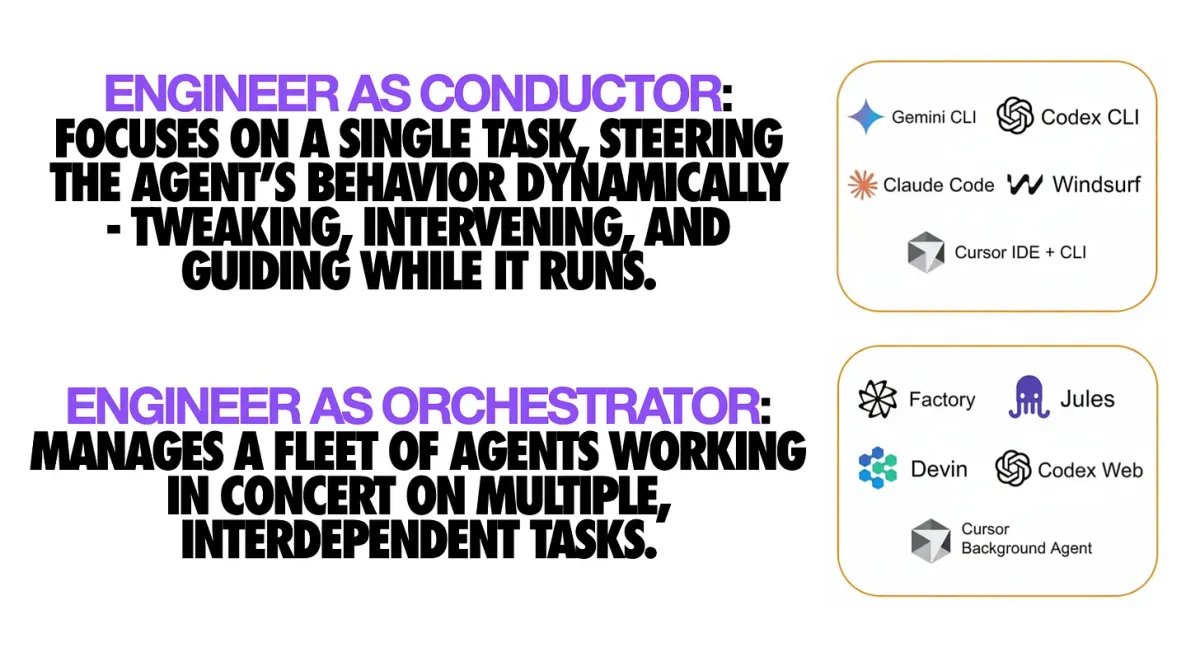From Conductor to Orchestrator: The Future of AI Programming

Preface
> Translated from Addy Osmani’s article: Conductors to Orchestrators: The Future of Agentic Coding, published November 1, 2025.
---
Executive Summary
We are entering a new era in AI-powered programming, where developers evolve from conductors to orchestrators.
- Conductor Model – Relies on cognitive leverage: AI amplifies individual execution, but human time remains a bottleneck.
- Orchestrator Model – Utilizes management leverage: AI becomes a digital team, enabling parallel task execution that transcends individual attention limits.
This transformation continues the long history of abstraction in software engineering — from machine code, to high-level languages, to frameworks — all designed to maximize human cognition. Autonomous AI agents are the most radical step yet, replacing much of the “how to do” with automated execution.
In this future, developer value focuses on two irreplaceable elements:
- Defining Intent – Deciding what and why to build.
- Applying Judgment – Assessing the quality of results and taking responsibility.
Engineers will be liberated from repetitive implementation to focus on problem definition and quality assurance. The measure of a developer’s worth will shift from lines of code written to value created by their AI teams.
---
Introduction
AI coding assistants have surged in adoption — 90% of developers now use them. But we are on the cusp of a deeper transformation:
- Moving from a single AI assistant to teams of autonomous coding agents.
- The developer role transforms from Conductor (guiding one agent) to Orchestrator (managing multiple agents).
This is not just a tool upgrade, but a workflow revolution:
> From “How do I write this code?” to “How do I ensure the right code gets built efficiently?”
---
Essence of Orchestration Tools
Conductor Mode – Guiding a Single Agent 🎸
Acting as a conductor means close, real-time collaboration with one AI agent.
Characteristics:
- Continuous tight feedback loops.
- Human initiates every step and reviews every change.
- Tasks happen in ephemeral sessions (context is lost unless documented).
- Ideal for focused, single-threaded work.
Example Tools:
- Claude Code CLI – Interactive coding in shell/IDE.
- Gemini CLI – Large-context AI planning and coding.
- Cursor IDE – Deep project-context understanding.
- VSCode, Cline, Roo Code – AI coding assistants under human guidance.
---
Orchestrator Mode – Managing Multiple Agents 🎼
An orchestrator coordinates many agents working in parallel — similar to a technical lead managing a development team.
Characteristics:
- AI agents have high autonomy — branching, coding, testing, committing independently.
- Engineers focus on coordination and reviewing PRs, not micromanaging.
- Workflows are persistent and traceable in version control.
- Enables asynchronous, concurrent execution.
Example Tools:
- GitHub Copilot Code Agents – AI that autonomously delivers PRs from assigned GitHub issues.
- Jules (Google) – Transparent workflow AI with user steering.
- OpenAI Codex Cloud Agent – Switches between conductor and orchestrator modes.
- Claude Code (Web) – Hosted agent for GitHub repo tasks.
- Cursor Background Agents – Multi-agent orchestration with full dev lifecycle automation.
- Other Platforms – Melty Labs Conductor, Claude Squad, Azure AI orchestration tools.
---
Conductor vs. Orchestrator – Key Differences
| Aspect | Conductor | Orchestrator |
| --- | --- | --- |
| Scope | Micro – individual tasks | Macro – multi-agent project goals |
| Autonomy | Low – constant oversight | High – independent execution |
| Workflow | Synchronous | Asynchronous |
| Deliverables | Often ephemeral | Persistent (branches, PRs) |
| Human Effort | Continuous involvement | Primarily at start & end |
Example:
- Conductor: Works step-by-step with AI to complete backend, frontend, and tests sequentially.
- Orchestrator: Delegates backend to Agent A, UI to Agent B, tests to Agent C — work is parallel, review happens later.
---
Why Orchestration Matters
Autonomous agents are the next abstraction layer in programming.
When 80–90% of code is AI-generated and humans guide the rest, productivity could rise dramatically. Small teams could achieve what once took months for larger groups.
New Developer Skills:
- Breaking work into tasks.
- Communicating requirements to AI clearly.
- Reviewing and validating outputs.
- Managing multi-agent workflows.
---
Future Development Lifecycle with AI
In orchestrator-driven software teams, specialized agents handle different phases:
- Planning Agents – Break down features/bugs into tasks.
- Coding Agents – Implement functions or fixes.
- Testing Agents – Create and run validation suites.
- Review Agents – Ensure quality and standards compliance.
- Documentation Agents – Update project docs.
- Deployment Agents – Release and monitor systems.
Human engineers oversee and integrate the process, focusing on strategy and quality.
---
Challenges Ahead
- Quality Control – Human review remains essential.
- Coordination & Conflicts – Branch isolation and clear task division are key.
- Shared Context – Requires unified orchestration layers.
- Requirement Definition – Precise prompts and specifications are crucial.
- Debugging – Humans must step in when agents stall.
- Ethics & Responsibility – Compliance, security, and bias mitigation remain human duties.
---
Conclusion – The Future Role of Engineers
By the late 2020s, engineers may:
- Spend less time typing code.
- Spend more time reviewing AI output.
- Transition between conductor and orchestrator roles depending on context.
Key Competitive Edge:
Engineers who master both modes — precision control AND scalable delegation — will lead the field.
Platforms like AiToEarn官网 illustrate orchestration beyond coding — integrating AI generation, publishing, analytics, and ranking into a unified system. This parallels future coding workflows where AI and humans collaborate seamlessly.
> The future of coding is not AI vs Humans, but AI + Humans — a combined force guided by human judgment, creativity, and purpose.
---
Final Thought:
Manual coding of thousands of repetitive lines will soon seem as outdated as manual accounting. Delegation to AI will become as routine as CI/CD pipelines today. The keyboard will remain, but increasingly to direct an intelligent team rather than to manually construct every component.
---
If you want, I can also create a visual comparison diagram showing "Conductor vs Orchestrator" workflow with timelines and task delegation — which would make this Markdown even more engaging for readers. Would you like me to add that?




